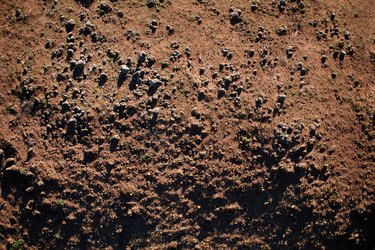
PCS (Petroleum Contaminated Soil) is described as any earthen material or artificial landfill that has human or natural alteration of its biological, physical, radiological or chemical composition resulting from the introduction of crude oil or any petroleum-based product such as diesel, gasoline or motor oil. Testing is used for detecting and monitoring petroleum aromatic hydrocarbons in soil.
Step 1
Place a scoop of the soil in question in a glass container with a lid. Cover with water and shake vigorously. Allow the water to settle and all sediment to fall to the bottom of the water. Allow to sit for a couple of days. If there is petroleum or hydrocarbon by-products present in the sample, oil will separate from the soil particles and will float on the top of the water. Even small percentages of hydrocarbon will make a "rainbow" or an iridescent film on top of the water. Basic field tests can help gather information to know if hydrocarbons are present in the soil; a chemical analysis will be necessary for more accurate information about petroleum content and properties. (This same test will reflect soil content, clay will settle to the bottom, then sand and silt will layer on top of the clay. Percentages of these materials are then visually determined.)
Video of the Day
Step 2
Contact a professional testing lab to conduct tests for methane mitigation and hydrocarbon residue. Methane gas, commonly found in combination with other hydrocarbons, can build up under buildings. Gas build-up presents a danger of explosion. Methane gas probe tests require the services of a professional testing lab.
Step 3
Use a disposable, portable petroleum analyzer kit, available from manufacturers of chemical analysis laboratory equipment or from an oilfield supply house. Digital analyzers measure the concentration levels of petroleum hydrocarbons present in sediment, soil and water. The equipment is ideal for use in the field. Calibrated to provide exact measurements of the quantitative amounts of specific petroleum products, the test will distinguish between Brent crude, diesel fuel, leaded and unleaded gasoline, lubricating oil and weathered gasoline.
Video of the Day